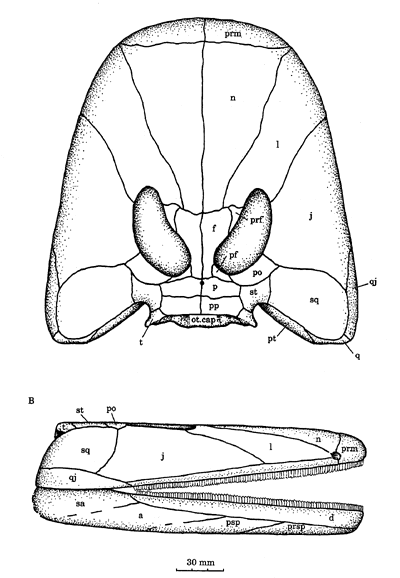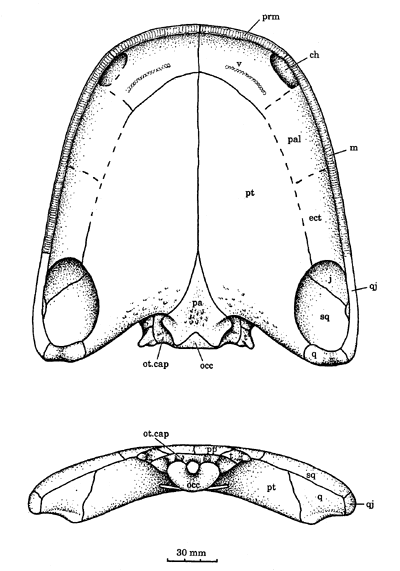 |

|
Spathicephalus: skull in dorsal and lateral views. |
Spathicephalus: skull in palatal and occipital views. |
From Beaumont & Smithson (1998). |
|
| Tetrapoda | ||
| The Vertebrates | Spathicephalus |
| Vertebrates Home | Vertebrate | Vertebrate |
|
Abbreviated Dendrogram
Sarcopterygii
│
└─Tetrapoda
├─Acanthostega
└─┬─Ichthyostega
└─┬─Crassigyrinus
└─┬─Colosteidae
│ └─Greererpeton
└─┬─Spathicephalus
└─┬─Baphetidae
├─Eucritta
└─Tetrapoda*
├─Temnospondyli
└─┬─Lepospondyli
└─Reptiliomorpha
|
Contents
Overview |
Like some of the much earlier Silurian galeaspids and the much later Triassic plagiosaurs Spathicephalus somehow made a living with an almost two-dimensional head. Exactly how it managed to do so is -- as with galeaspids and plagiosaurs -- a matter of considerable uncertainty. The enormous jaw and flat head making closing the mouth against the resistance of water a major concern. But the size of the antorbital fossa and the adductor chamber suggest that the jaw adductors were actually weaker than comparable organisms of the same, more or less baphetid, design.
Of course the peculiar teeth of Spathicephalus tell us that it did not feed in the same way. Unlike the baphetids, Spathicephalus had numerous small, thin teeth, no fang pairs, and very few denticle-bearing areas on the palate. The teeth seem to have present all at the same time, as opposed to the usual tetrapod arrangement involving unsynchronized replacement of a smaller number of large teeth. The theory seems to be that Spathicephalus strained water or substrate through these teeth.
Spathicephalus: S. mirus Watson 1929; S. pereger Baird 1962.
Range: Early Carboniferous (Serpukhovian or Namurian A) of North America (Nova Scotia) and Late Carboniferous (early Bashkirian or Namurian B/C) of Europe (Britain).
Phylogeny: Tetrapoda :::::: (Baphetidae + Tetrapoda*) + *.
 |

|
Spathicephalus: skull in dorsal and lateral views. |
Spathicephalus: skull in palatal and occipital views. |
From Beaumont & Smithson (1998). |
|
Characters: skull length to 22 cm [BS98]; skull very flat, broad & blunt [C02] [BS98]; skull width almost equal to length [BS98]; snout bones laterally expanded [BS98]; internasals absent [BS98]; antorbital large & vacuity smoothly continuous with orbit no "key-hole") [BS98]; orbits closely spaced & strongly excavated [C02] [BS98]; orbits set 75% skull length back [BS98]; orbits face dorsally [BS98]; frontals enter orbit margin with thickened interorbital bar [BS98]; skull table very short [BS98]; intertemporal absent [BS98]; supratemporal forms anterior border of otic notch [BS98]; small pineal opening [BS98]; tabular horns and tabular posterior boss present [BS98]; quadratojugal strongly sutured to quadrate [BS98]; single occipital element [BS98]; occipital bone(s) makes no contact with skull table [BS98]; posttemporal fenestra absent [2] [BS98]; supraoccipital absent [BS98]; braincase: otic capsules broad & well ossified [BS98]; otic capsules strongly attached to skull roof [BS98]; stapes robust with large plate-like foot on fenestra ovalis and large distal region resting against quadrate ramus [BS98]; parasphenoid broad, forming floor of fenestra ovalis [BS98]; widely separated basipterygoid processes [BS98]; parasphenoid sutured to basipterygoid processes [BS98]; cultriform process short & narrow [BS98]; palate: premaxilla without midline buttress [BS98]; pterygoids sutured along midline and probably fused with basipterygoid processes [BS98]; pterygoids, vomers & parasphenoid ornamented with pits & ridges (as pterygoid quadrate ramus of baphetids) [BS98]; pterygoid quadrate ramus forms medial wall of adductor fossa and meets squamosal dorsally [BS98]; lower jaw: very shallow (22 mm in known specimen) [BS98]; dentaries & presplenials strongly sutured and immobile [BS98]; parasymphysial plate present apparently with row of small teeth) [BS98]; parasymphysial teeth point medially, toward opposite ramus [BS98]; coronoids without denticles, but with fine ornamentation [BS98]; dentition: all teeth small, chisel-shaped and numerous [C02] [BS98]; vomer with row of smaller teeth [BS98]; teeth pectinate (filter feeder?) [C02]; teeth all present at same time [C02]; dentary tooth count probably 110-120 [BS98]; palatal bones & coronoids without denticles [BS98]; postcranial: interclavicle rhomboidal [B77].
Note: [1] Spathicephalus is shown as outside the Baphetidae because that's the way it came out when scored and run using a slightly modified version of the database of Clack (2001). No one has much confidence in any of the cladistic results in this area of phylospace at the moment. However, Spathicephalus scores so consistently primitive in many different runs, that this placement may be correct. This makes the Loxommatoidea (Baphetidae + Spathicephalus) paraphyletic. This is perhaps unlikely, but not really any stranger than most other possibilities. [2] This may be a matter of definition. The geometry of the occiput is odd, because the whole structure is so vertically compressed, laterally extended, and strongly fused. In addition, the extent of vertical compression has been exaggerated by crushing during preservation. It may be impossible to say exactly what the exact state of the occiput might have been at this point.
Links: Amphibian Skull
References: Beaumont (1977) [B77]; Beaumont & Smithson 1998) [BS98]; Clack (2001); Clack (2002) [C02]. ATW020820.
checked ATW040813